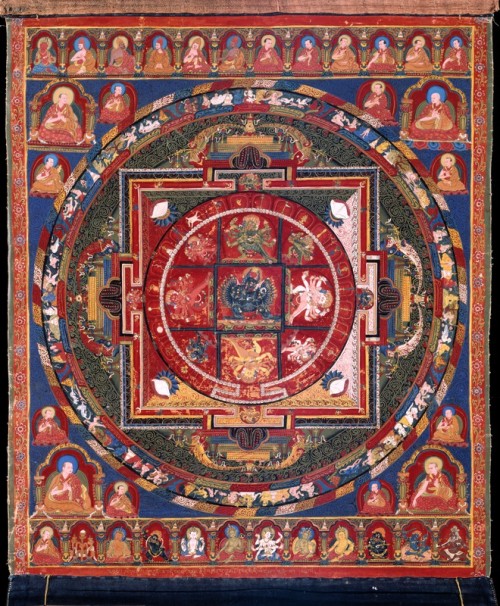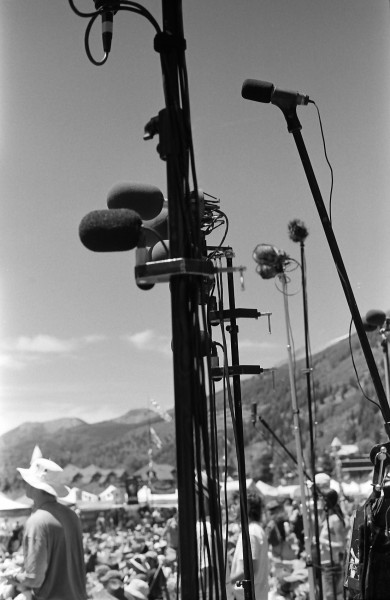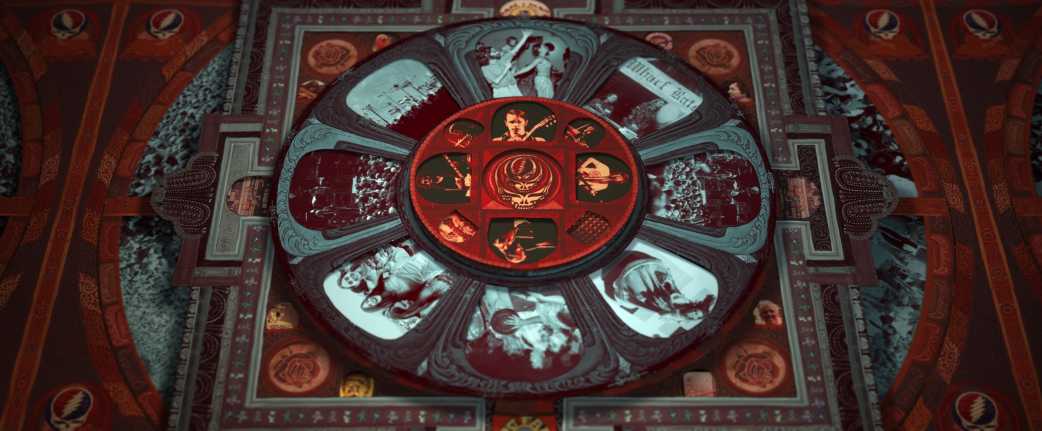
Art can lead to spiritual transformation. If you’ve ever been to the Rubin or studied Himalayan artworks, you know that mandala paintings are often created as tools for meditation and the pursuit of a higher spiritual state. But is the power of a mandala constrained to the religious context of Himalayan Buddhism?
Author Steve Silberman can’t help but spot patterns in other realms of experience. His award-winning history of autism, NeuroTribes, made sense of a previously unknown pattern in medical history that helps explain the dramatic rise in autism diagnoses that began in the 1990s. Silberman is not only well-versed in Buddhism, but he’s also one of the most knowledgeable Deadheads, the legendary Grateful Dead fan community. Earlier this year, Silberman joined filmmaker Amir Bar-Lev at the Rubin for a sneak preview of the new Grateful Dead documentary Long Strange Trip. The documentary, now available to stream on Amazon Prime Video, features several mandalas from the Rubin’s collection.
In order to understand the significance of mandalas to the Grateful Dead and Deadhead fan community, we turned to the expert himself:
The Rubin: Mandalas have many layers of meaning and can be interpreted in different ways across cultures. What are your thoughts on the sacred figure?
Steve Silberman: I’ve been a practicing Zen Buddhist since I was nineteen. My time studying at the Naropa Institute in Boulder, Colorado, founded by Kagyu lineage-holder Chögyam Trungpa Rinpoche, informed my understanding of mandalas. As far as I understand it, mandalas are used in Vajrayana practice as focus points for meditation and visualization. Tibetan Buddhists visualize mandalas in great detail. They practice visualization to evoke various sacred energies and then manifest them in their own lives.
When people think of spiritual practices, they tend to think of the “nice” stuff—light and love and all that. In the Vajrayana tradition, however, mandalas also contain elements of confusion, suffering, and neurosis. By bringing these energies into the field of practice too, Trungpa’s students were taught to make them “workable,” as he put it, rather than rejecting them as un-dharmic or something. He taught that all sentient beings have “basic goodness” that can be cultivated with practice, even in states of neurosis and confusion.

Another aspect of my understanding of mandalas comes from Carl Jung’s work, Man and His Symbols. During Jung’s spiritual crisis, he spontaneously started drawing mandalas, and eventually believed them to be representative of profound psychological transformation. He was interested in mandalas not just as art or meditative objects, but as archetypal symbols that appear in the human psyche on the precipice of spiritual change. It’s as if our brains are programmed to imagine mandalas at important times. I myself have had this experience. At a time of profound psychological crisis in my life, I started seeing mandalas everywhere—even in octagonal “STOP” signs! That turned out to be a sign that the crisis was coming to a point of healing.
How does the mandala relate to the Grateful Dead and their live music?
Reading Trungpa Rinpoche’s writings at Naropa, I learned that the mandala goes beyond the visual object itself but also acts as a container for transformational energy—a sacred space. He taught that when Buddhists come together to receive a teaching or perform a practice together, they’re creating a container for something transformative.
If you were a regular at Grateful Dead shows, you would see familiar people each time you went. Deadheads would spontaneously map themselves into a circular pattern in the seating area around the stage. As in mandalas, there would be various regions of the audience that consisted of specific populations and energies.

For example, a region of the audience called the “taper section” was filled with people using ultra-high quality tape recording equipment. Since every single Dead show was different—in song selection, and the transitions between songs—every show felt new, and fans wanted to capture those unique moments. The tapers became their own community. One thing wonderful about the taper section was that people wouldn’t talk because they knew any stray remark would be immortalized on tape. So it was a great place to hang out for people who didn’t want to hear people talking over the music.

Then there was “the Phil Zone” near the side of the stage where Phil Lesh, the bass player would perform. There, you could literally feel Phil’s bass notes, amplified through the Dead’s legendary sound system, vibrate every bone in your body. Another region of the mandala—often out in the hallways, where the Dead set up a little sound system specifically so people could dance there— was a group that called itself the Spinners, a Christian cult who thought Jerry Garcia was an avatar of God, revealing sacred information to them through his guitar. In Long Strange Trip, I reference Carl Jung’s concept of the “collective unconscious,” and observe that the Dead were able to tap into ancient archetypes stored in the collective unconscious and evoke them during their concerts, particularly because many Deadheads used psychedelics as aids to their personal spiritual quests.
Do you think the Grateful Dead translated the visual elements of a mandala into the sound of their music?
I don’t think so. The whole situation of the band’s unusually intimate relationship with its audience, and the fans’ eagerness for a transformative experience at shows resulted in the band being perceived as having some of the potency of deities in a traditional mandala. But that parallel was not intentionally imposed or anything like that—in fact, lead guitarist Jerry Garcia intentionally subverted those projections every chance he got. (“I’ll put up with it until they come for me with the cross and nails,” he says hilariously in the film.)
However, Mickey Hart, one of the two drummers, is very familiar with Tibetan culture and Tibetan music. During the second set of a concert, the guitarists would leave the stage, and Mickey and Bill Kreutzmann would play music that tapped into ancient rhythms from cultures worldwide: the “drums and space” section of the show. A couple of times, Mickey brought Tibetan monks out to do overtone singing during space, which was really heavy. Mickey is aware of how sounds and rhythms can evoke primordial experiences of order and chaos, and the whole band danced between those two extremes; of sheer free improvisation on one hand, and traditional song structure on the other.

Much more than other bands, they lived up to the notion that you did not have to go with a prepared set or do the hits, and you can still become one of the highest-grossing bands in history. The Dead were a signpost to freedom in music for a whole generation of younger bands who are now expressing that freedom in their own ways, which may sound nothing like the Dead. That’s not only fine, that’s better than mimicking the Dead.
For a lot of Deadheads who grew up in the spiritual wasteland of suburbia, like me, following the Dead became something like a spiritual path itself. But you soon learn that you can’t stay high all the time without wrecking your life and ignoring things that shouldn’t be ignored, and the “post-show glow” would inevitably wear off. So you had to go find a more complete path—one that you could practice in sobriety, working with what Buddhists call “ordinary mind.” I know a lot of Deadheads who eventually became practitioners of meditative paths. So the Dead acted as a gateway in that sense: you would mature from yearning for the eternal buzz to finding a way to deal with what Zen teachers call “the Great Matter of Life and Death” even when the Dead were no longer in town to give you a boost.
Watch the trailer for Long Strange Trip below and feel the power of sound first-hand at the Rubin’s newest exhibition, The World Is Sound, open through January 8, 2018.
About Steve Silberman
Steve Silberman is the author of NeuroTribes: The Legacy of Autism and the Future of Neurodiversity (Avery 2015), which the late neurologist Oliver Sacks called a “sweeping and penetrating history”¦presented with a rare sympathy and sensitivity.” The book won the 2015 Samuel Johnson prize for non-fiction and was chosen as one of the Best Books of 2015 by the New York Times and many other publications. It was recently optioned by Paramount for a potential feature film. He also co-produced the Grateful Dead’s box set So Many Roads (1965-1995) and saw more than three hundred Dead shows. He was also poet Allen Ginsberg’s teaching assistant at Naropa University. He lives in San Francisco with his husband Keith.

